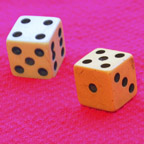

 |
Number game with dice |
 |
This game is suitable for children in elementary grades. Be sure to use decimal numbers!
![]() Tools:
Dice, paper, pencil
Tools:
Dice, paper, pencil
1. How to get the digits 0 to 9 randomly with two dice.
Throw two dice simultaneously. Add the points and interpret the scores as follows:
| Score (sum of numbers on two dice): | Digit assigned to this score: | Probability that this score will occur: |
| 2 | 2 | 1/36 |
| 3 | 3 | 2/36 |
| 4 | 4 | 3/36 |
| 5 | 5 | 4/36 |
| 6 | 6 | 5/36 |
| 7 | 7 | 6/36 |
| 8 | 8 | 5/36 |
| 9 | 9 | 4/36 |
| 10 | 0 | 3/36 |
| 11 | 1 | 2/36 |
| 12 | 2 | 1/36 |
This gives the following distribution for the digits 0 through 9 (if the dice are fair):
| Digit assigned to a given score: |
0 | 1 | 2 | 3 | 4 | 5 | 6 | 7 | 8 | 9 |
| Chance it will occur: |
1/12 | 1/18 | 1/18 | 1/18 | 1/12 | 1/9 | 5/36 | 1/6 | 5/36 | 1/9 |
2. How to play the game.
Two students play at the same time, competing against each other.
Each student prepares room for a 5-digit decimal.
Score
_ _ _ . _ _
Then they throw a pair of dice five times. Each student puts the resulting digit in a decimal place of his or her choice. (You are not allowed to see what your opponent is doing!). After the game is finished the student whose number is bigger gets 1 point. If the numbers are equal, each student gets one half of a point.
Example of a game.
| Outcome of a throw: | First student: | Second student: | |||||||||||||||||||||||||||||||||||||||||||||||||||
| 6 |
|
|
|||||||||||||||||||||||||||||||||||||||||||||||||||
| 0 | |||||||||||||||||||||||||||||||||||||||||||||||||||||
| 8 | |||||||||||||||||||||||||||||||||||||||||||||||||||||
| 7 | |||||||||||||||||||||||||||||||||||||||||||||||||||||
12 (so the digit 2 is assigned) |
|||||||||||||||||||||||||||||||||||||||||||||||||||||
| Outcome: | 876.20 |
> | 872.60 |
||||||||||||||||||||||||||||||||||||||||||||||||||
| Score: | 1 point | 0 points |
Students may play 3-, 5-, or 7-game matches. You may arrange a class tournament, and so on.
Students should be required to read the numbers correctly.
Remarks about competitions.
Most children like to compete, if they think that they have a chance to win.
So as long as winners and losers vary, playing the game may be continued. But
when some students start winning consistently and others start consistently
losing, the game should be discontinued.
Remark about this game.
The best methods of playing in a single game or in a tournament are far from
being obvious. So it is possible that at least some children will find it interesting
and challenging.
Remark about how the probabilities of the scores in 1. above were computed.

From the table above we see there are 36 possible outcomes, with the frequencies given below:
| Outcome: | number of times this outcome occurs (see table): |
probability: |
| two | 1 | 1/36 |
| three | 2 | 2/36 = 1/18 |
| four | 3 | 3/36 = 1/12 |
| five | 4 | 4/36 = 1/9 |
| six | 5 | 5/36 |
| seven | 6 | 6/36 = 1/6 |
| eight | 5 | 5/36 |
| nine | 4 | 4/36 = 1/9 |
| ten | 3 | 3/36 = 1/12 |
| eleven | 2 | 2/36 = 1/18 |
| twelve | 1 | 1/36 |
| All Possible Outcomes | 36 | 1 |